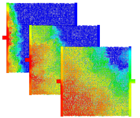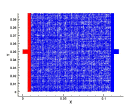 back back |
 up up |
||||||||
 |
 |
||||||||
| Written By: Kambiz Nazridoust | |||||||||
|
Introduction | |||||||||
|
Increasing atmospheric concentrations of greenhouse gases are suspected of causing a gradual warming of the Earth's surface and potentially disastrous changes to global climate. Because carbon dioxide (CO2) is a major greenhouse gas, CO2 sequestration is being explored as one possible approach to limit the accumulation of greenhouse gases in the atmosphere. Carbon sequestration, sometimes referred to more broadly as carbon management, is a way to reduce greenhouse gas emissions while still enjoying the benefits of fossil fuel use. This strategy represents a complementary approach to the current CO2 mitigation efforts of improved energy efficiency and increased use of non-carbon energy sources. Interest has been increasing in the carbon management option because it is very compatible with the large energy production and delivery infrastructure now in place and because non-fossil energy sources face large barriers, renewables are very expensive and nuclear has public acceptance problems. Sequestration covers technologies that capture carbon at its source (e.g., power plants, industrial processes) and directs it to non-atmospheric sinks (e.g., depleted oil and gas reservoirs, deep saline formations, deep ocean), as well as processes that increase the removal of carbon from the atmosphere by natural processes (e.g., forestation). A comprehensive overview of this subject can be found in a U.S. Department of Energy (DOE) white papers in 1997. In this work, a porous glass cell is used to observe the behavior of a multiphase flow of gas and liquid. The CO2 sequestration experiment at Clarkson University is funded by US Department of Energy and National Energy Technology Laboratory (NETL). |
 |
||||||||
 |
|||||||||
| Motivations | |||||||||
1-Sequestration of CO2 by injection into deep geological formations |
|||||||||
| Computational Modeling | |||||||||
FLUENT™ CFD package is used to solve the flow field in the a two dimensional model of the flowcell. Multiphase flow of air-water is solved for laminar flow. The model of the cell is made in AutoCAD after vectorizing the picture of the cell and then using the Gambit™ preprocessor it is meshed. Volume of Fluid (VOF) model is used to find the volume fraction of air/water. Surface tension of water is also considered in the calculations. A movie of is also shown here. A three dimensional model of the cell is under development which will the exact model of the actual flowcell. |
 |
||||||||
| Experiment | |||||||||
|
The experiment consists of a flow cell, a camera, a pump, a pressure transducer, and a computer for saving and analyzing the images. First the cell is filled with a basic fluid (defending fluid), water for example, and another fluid (invading fluid), like air, is injected into the cell using the pump. The camera takes images from the cell and the movement of the fluid inside it. The mass flow of the injected fluid is controlled by pump. In every second, a value for pressure is taken from the pressure transducer and is saved on the computer. The experiments has done for different orientation of the cell and various flow directions. For more information please contact Joshua Cook. |
 |
 |
|||||||
|
Copyright © Kambiz Nazridoust, 2005. |
 back back |
 up up |
|||||||